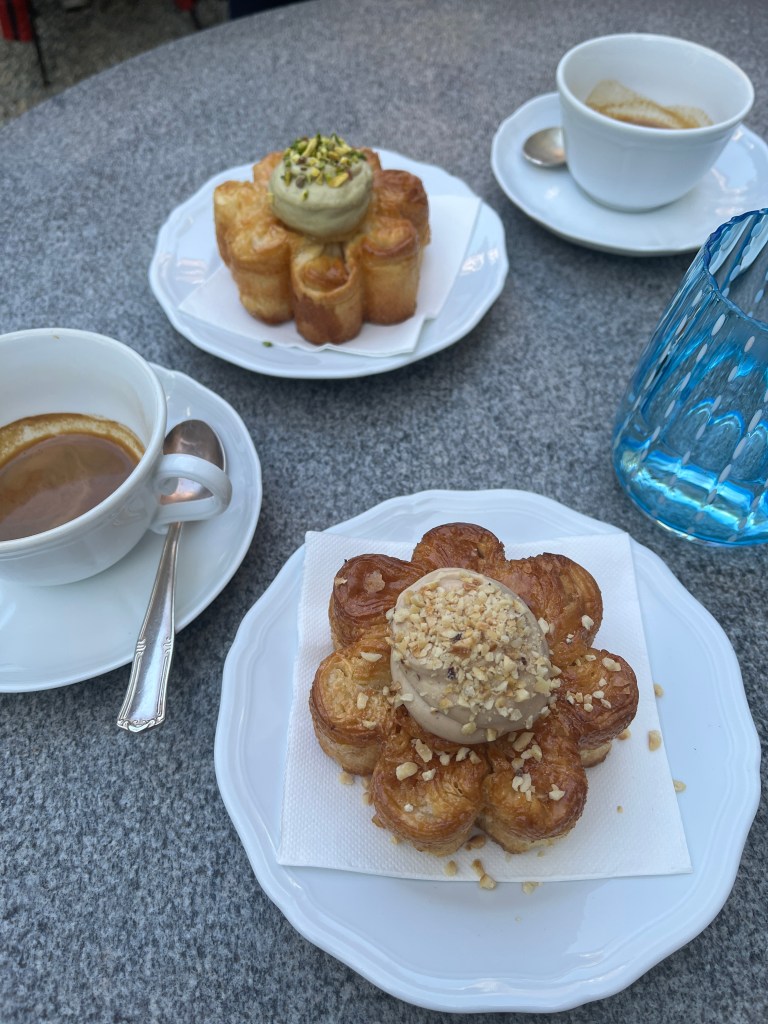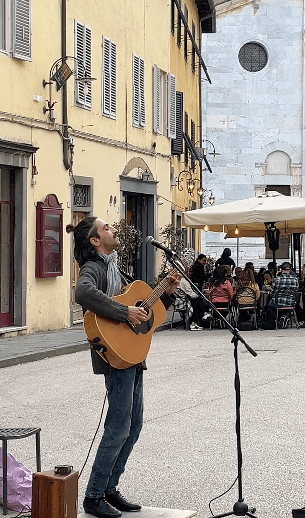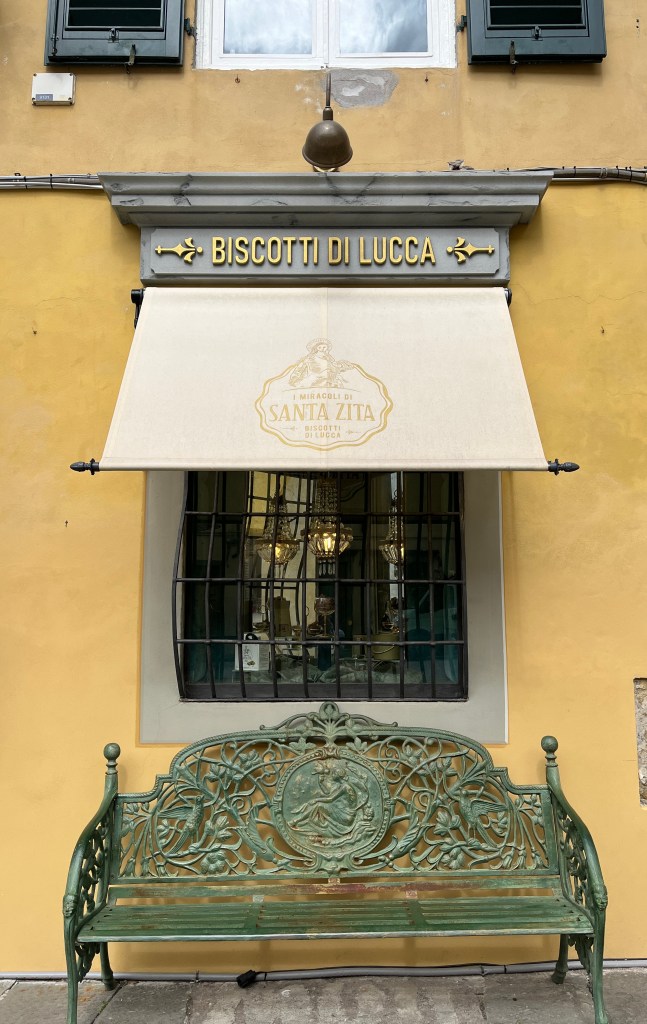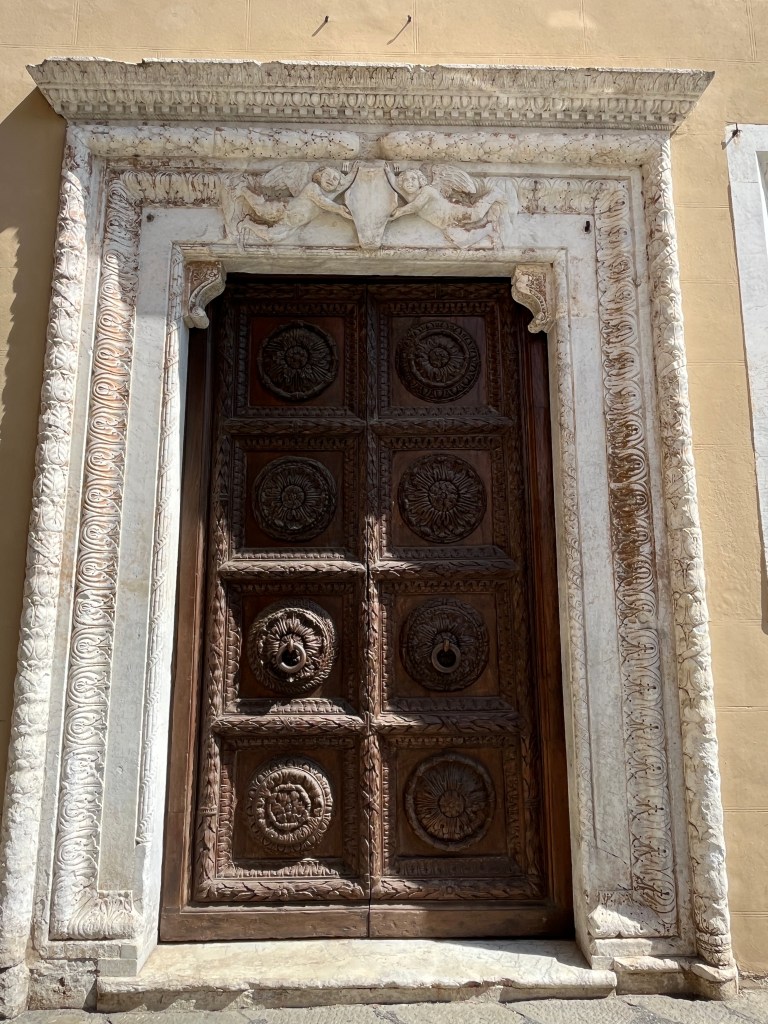


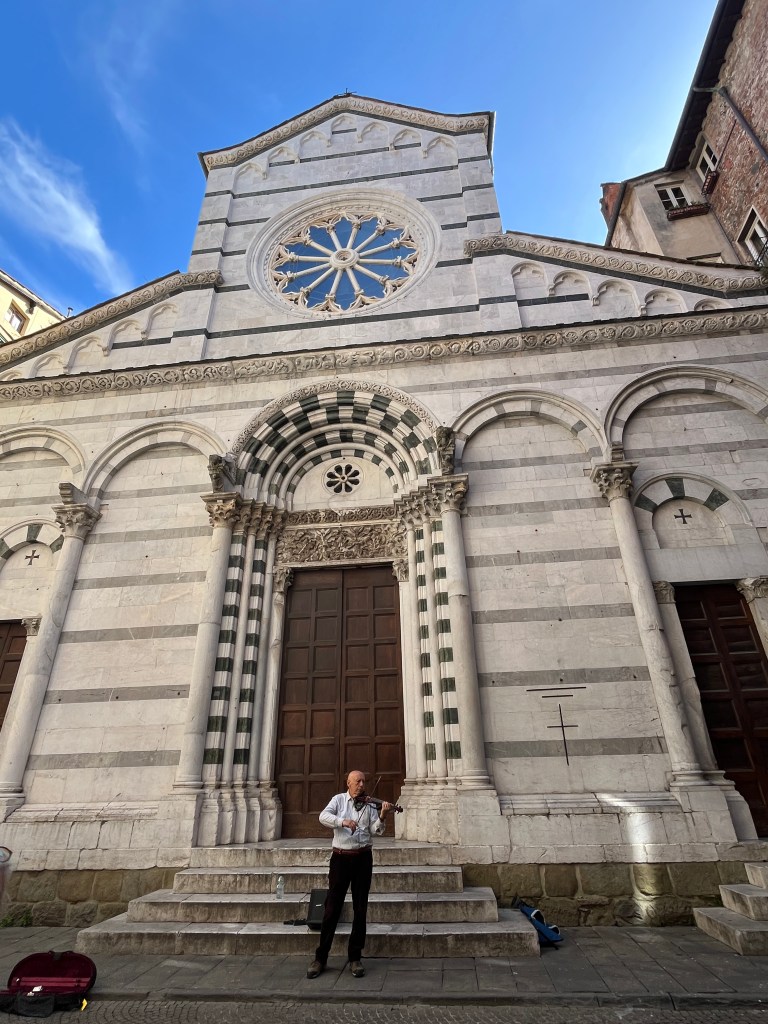
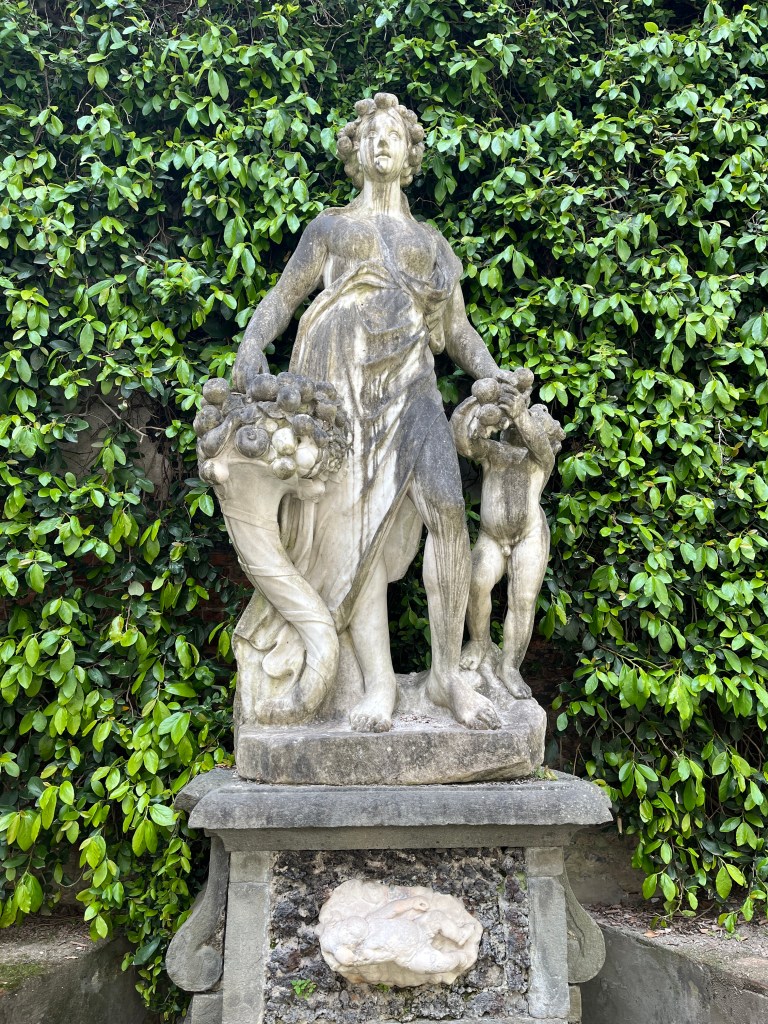

Our two week sojourn in this charming city comes to an end on a gorgeous, sun-filled evening… just the serendipitous way it was meant to. After strolling the city walls one last time, Bruce urges me to climb the Guinigi Tower with him, that one historic icon of the city we’ve left unexplored. But I’m exhausted. My legs have carried me along myriad streets over the past three weeks, up endless stairs and hills – Rome, the Amalfi Coast, Pompeii, Perugia, Lucca – and I simply can’t move another step. “You go ahead, I’ll perch myself right here,” motioning to a stone bench set into the walls of the Palazzo Guinigi. As was often the case in the grand palazzi of the 13th and 14th century, benches lined one side of the expansive home, a place for visitors to wait or for the common folk to linger. I eye the bar across the narrow Via Sant’ Andrea – seeing others happily enjoying a cocktail. “I’ll be right here on my ancient ‘bar seat’ with a glass of wine. Enjoy the view up there!”



As the hour passes, I count my blessings for the unexpected treasure that is Lucca. I had twice been here but only briefly, and choosing Lucca (and later Cortona) for the first of our leisurely two-week stints has been a wonderful revelation. Lucca’s compact inner city, inhabited for over two-thousand years and still fully embraced by impressive ancient walls, is rich in culture, history and beauty. With its original Roman street layout, this once silk producing capital of Europe beguiles visitors with intriguing scenes around every corner… countless piazzas, ninety-nine churches and vibrant cafes.
The intact Medieval wall encircles the city. Topped by a broad pathway flanked by elderly trees, it offers four kilometres of cycling or walking and the views are superb. When we arrived two weeks ago, the soaring Sycamores were readying to unfurl their canopies. Now, spring is announced by their baby-green leaves, the heavenly scent of wisteria and the already lush rhododendrons blooming along the stone walls.


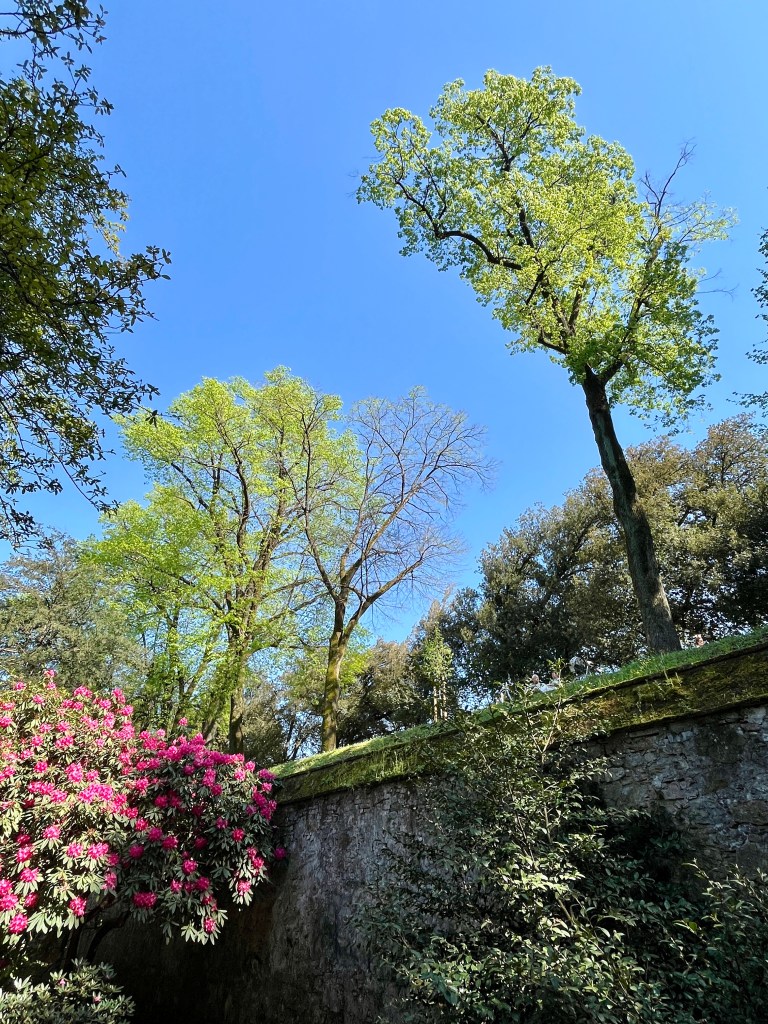
Bruce is back down from the quaintly tree-topped Guinigi Tower and orders a beer. “Quite the view in every direction, I could even see the marble mountains near Carara.” The Guinigi family clearly had the best view in town, as would have been expected of one of the most prominent families in Lucca. From the 1200’s onwards, noble and wealthy families in Tuscany built impressive urban tower houses, part palazzo and part stronghold… signs of power and economic prosperity. From these palatial perches, they were able to play a greater part in running the ‘commune’ of Lucca, one of the prominent city states of Tuscany. Only nine towers remain in Lucca today, yet as many as 250 defensive tower houses once framed the skyline. With narrow via and narrower still vicoli, and at times hemmed in by towers and four-storied buildings, Lucca can feel a little closed in at times. Yet there is always sunshine to be found in the piazzas!
I fall head over heels with the multitude of piazzas, piazzales and piazzettas – from grand squares, to not quite square-shaped squares to little postage-stamp corners that might be no more than the broadening of a street, marked by a tree or an ornate fountain. Let me take you to a few that became dear to me, for it’s here that the stories of lovely Lucca tend to reveal themselves.
Piazza San Michele

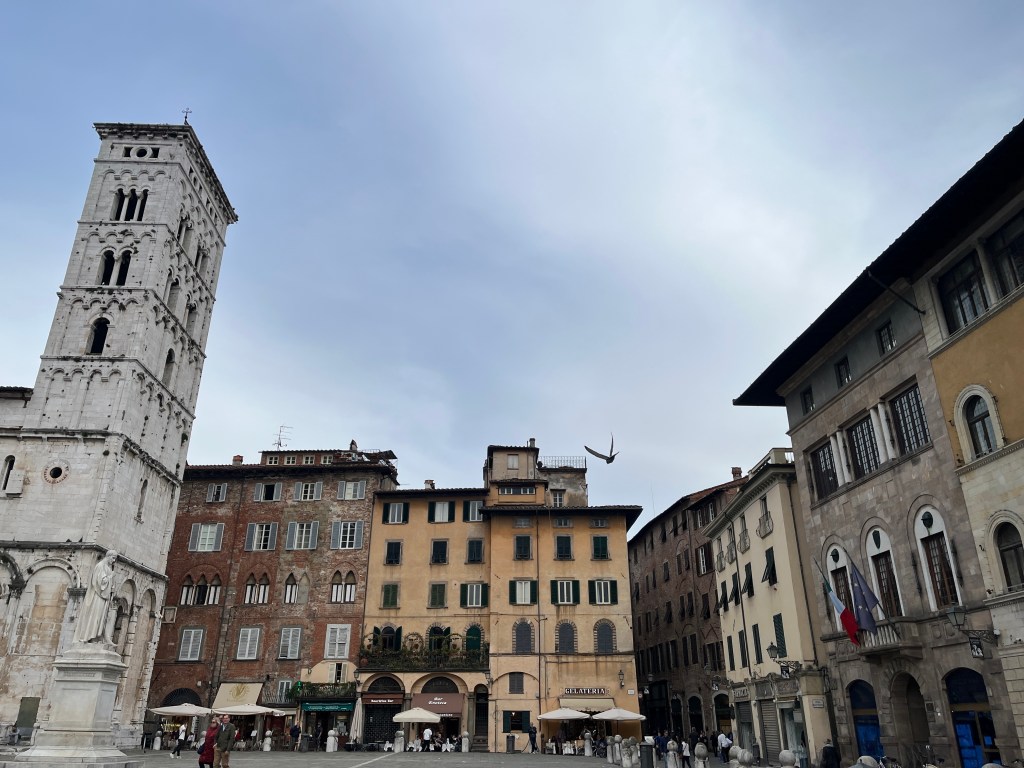


This is the beating heart and the crossroads of the city, where life swirls around you at any time of day. I have the feeling that writers over the centuries have claimed their favourite spot at one of the corner cafes on this massive square, for me it’s Caffe Casoli. Dal 1880 is indicated on its frontage – it’s been here awhile – but might still be considered a young upstart in this ancient town. From my usual perch, a wrought iron chair at the tiny round linen-decked table, I jot notes and observe. The square surrounds the Church of Saint Michele before me. Children kick a football, others play tag, parents chat and people of all ages settle themselves against the massive wall to savour their gelatos. Like many, I gaze up in admiration.

The great Church of Saint Michele was built over the ancient Roman forum – the Etruscans were here before that – with the church first mentioned in 795. In the middle ages it was a place of pilgrimage with a hospital nearby to care for pilgrims passing through on the Via Francigena. This ancient road ran from Canterbury in England, through France, Spain, Switzerland, and onward to Rome. Or if you were making the ultimate Christian pilgrimage, further yet to Apulia where ports of embarkation sailed you off to the Holy Land. Lucca was on this pilgrimage trail, just before Siena and Rome, yet the pilgrim road wasn’t only about the destination. The route facilitated an exchange of ideas, goods and trade in the 12 and 1300’s.
In the Middle Ages, rivalry between neighbouring towns was intense with churches being bragging pieces. From my vantage point, the facade of San Michele is a spectacular projection of power and a fine example of Tuscan architecture. I marvel at the 12 ft high statue of the Archangel Michael watching over his city, angels by his side trumpeting victory over sin. I love the horizontal stripes of muted whites, grey and green marble that define this and most of the churches in Lucca.
On the left side of the square, the elegant old family palaces – palazzi – still add grandeur to the setting. And to my left at the corner of Via Roma and Via Beccheria, is the intersection I never tire of. The Lucchese are in constant motion – bike riders, dog walkers, shoppers coming from the Farmacia, the Enoteca. Going about their day with so many visitors to contend with, at times I sense the occasional annoyance with the crowds, yet as always there is a certain style and grace as they live their daily life. And they never seem too busy to slow down and catch up with their friends along the street. Lucchese know the art of mingling and good conversation!



Piazza Cittadella


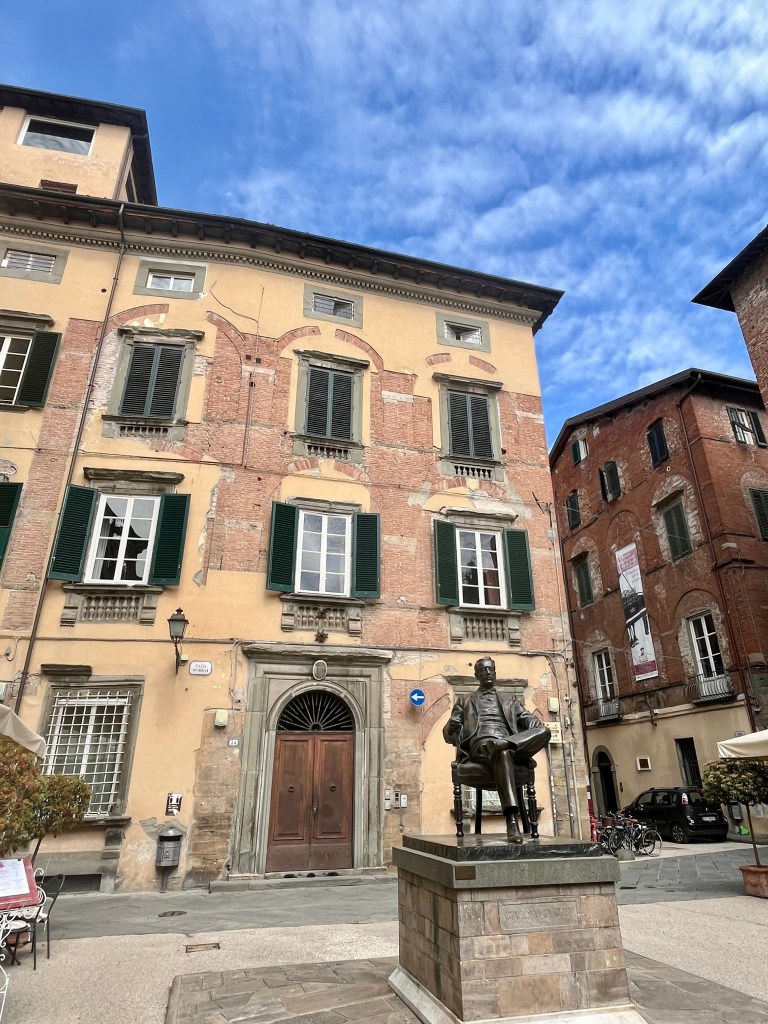
I‘m sitting at Madama Butterfly Caffe for a leisurely lunch as groups of tourists wander along and pose with the stately bronze statue of Giacomo Puccini. Once home to the celebrated composer, the cozy square is infused with hues of lemony yellows and ochres, white and faded green shutters and cafes aptly named after Puccini’s famous operas. After visiting the Puccini museum in the once family home, I understand Lucca’s pride in this dynasty of five generations of composers. The last, Giacomo, and his celebrated works that include Madame Butterfly, Tosca, La Boheme and Turandot, are interwoven into Lucca’s identity. From cafes and souvenirs, to impromptu recitals and evening operatic performances, Puccini is part of the experience of the city. Puccini, who passed away in 1924, would undoubtedly be thrilled to know that on evening after evening, people from around the world revel in the heavenly operatic performances of his masterful works… fantastic, assolutamente fantastico!


Piazza San Martino


“When’s the last time you came across a postcard cart?” I muse to Bruce as we wander into Piazza San Martino. “How terrific, it reminds me of my first time in Italy!”
The tiny shop on wheels is wonderfully incongrous against the luminous, grand Cathedral of San Martino. Postcards and guide books line the cart, leaving just enough space for the friendly seller to climb off and on the bike buried beneath his wares. Originally from Venezuela, Arron tells me he’s been selling here for some 25 years. I meet his dog Pongo who lies patiently in the shade of the cart. Periodically his master jumps on his e-scooter and they zip through the piazza for a quick ‘walk’ between customers. After our chat, Arron calls out a ‘Ciao bella,’ to me and thereafter each time I visit the square. I feel like there should be a postcard of him, Pongo and his timeless tiny shop!
Bruce and I go back a few times to gaze up at the Cathedral. We stare in wonder ; su, su, su – up, up, up – at the imposing, almost impossible ediface and tower. The 700’s were years of growth for Lucca – surrounding buildings were torn down to make space for the church and piazza. The creativity and the intricacy of the carvings on the facade of the church are every bit as outstanding as the chapel’s interiors and priceless works of art.


On a fine Sunday morning, the Cathedral becomes the backdrop for a celebration dear to the Lucchese. Each spring, they pay homage to their liberation from those pesky Pisans as the city honours the 1369 liberty of Emperor Charles IV exchanging Lucca to Pisa for a large sum of money… La Festa della Liberazione – Liberation Day. Lucca fought hard to maintain its continued independence from Pisa and Florence. These days Pisa is just a mere twenty minutes by train over the hills, one of my favourite Tuscan cities.
The costumes, musicians, and flag throwing is resplendent, evoking celebrations of the Middle Ages. Flags are sent spinning up into the air, are caught and tossed again. Four flags are handled at once to the huge appreciation and applause of the crowd. This craft dates back to medieval guilds in many European countries when a guild’s banner or flag was considered a symbol of purity. Best not to let it touch the ground or fall into enemy hands! As I crouch down to take video, a local asks me where I’m from, pleased that I’m witnessing the event. She wants me to know the importance of it all. I playfully ask if there’s still a rivalry between Lucca and Pisa? “Allora, maybe only in football,” she says with a wink.

Piazza San Frediano

This piazza becomes our ‘home square’. Just a stone’s throw from our apartment on Via Fillungo, there seems never to be a dull moment; whether during our strolls, cutting through the square to the nearby streets or while enjoying a glass of local Vermentino to the strains of musicians. Anchoring it all is the golden mosaic adorning the Roman Basilica of San Frediano. An Irish bishop in Lucca built a church on this spot in the early 500’s, yet the present day appearance is more an 1100’s version of Roman simplicity. It’s less grand than others, yet has a welcoming feel. I’m intrigued to hear the story of the church’s patron saint, Santa Zita.
Zita entered domestic service at the age of twelve, serving a prominent silk merchant family for almost fifty years. She was known for doing ordinary things well and for her kindness and generosity to the poor. It’s said that a star appeared above the bedroom attic at the moment of her death at sixty years old. After 150 miracles had been attributed to Zita’s intercession she was recognized by the church and canonnized in 1696. Guilds were established in her honour and still today on April 27th, families bake a loaf of bread and gather in celebration of Saint Zita. I notice that she’s portrayed with a bundle of keys and is the saint to invoke if indeed you’ve lost yours. Not possible for us – the iron key to our ancient accommodation is the size of a serving spoon!
Spending time in this square feels quintessentially Lucca, especially when beautiful melodies float this way from the nearby Music Conservatory. People stroll through on passeggiata while the bells toll their pleasant sonorous melody. ‘Meet me in the piazza’ becomes the phrase I say to Bruce if I’ve gone out and we plan to meet later for appertivo. He’ll know where to find me. And so we meet, we sit, we listen, we sip… late afternoon fades into evening.
